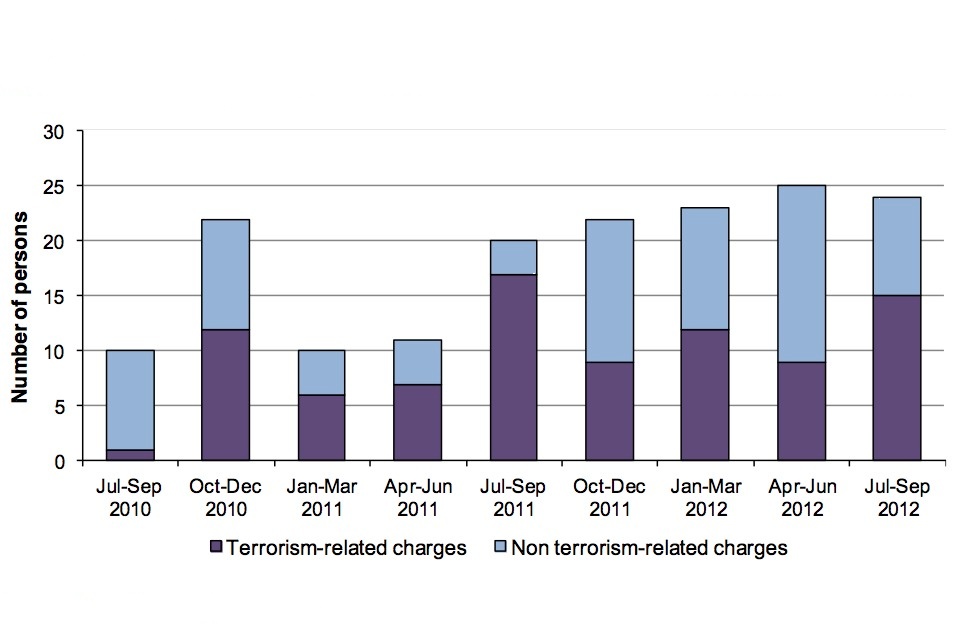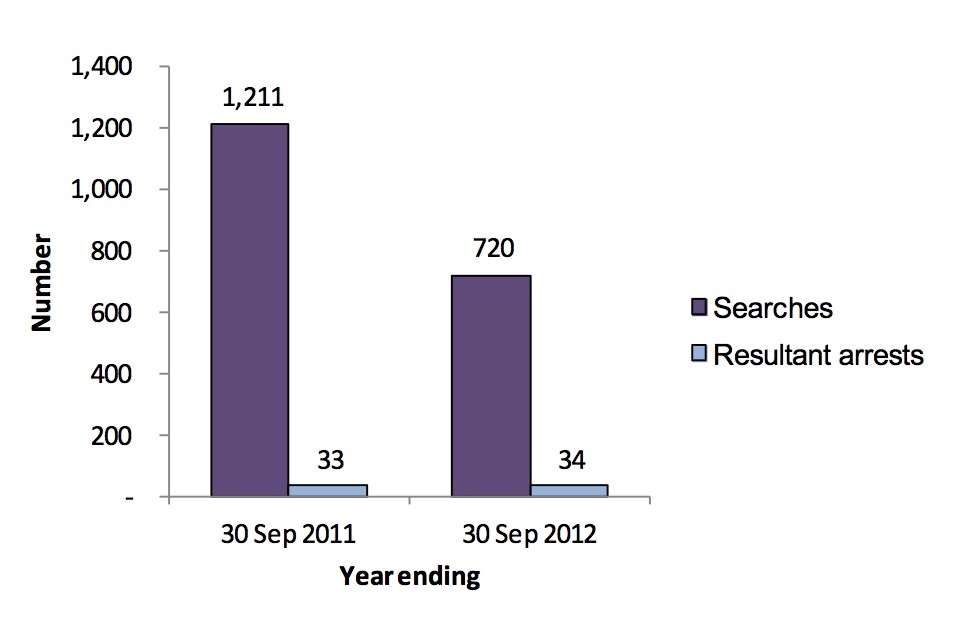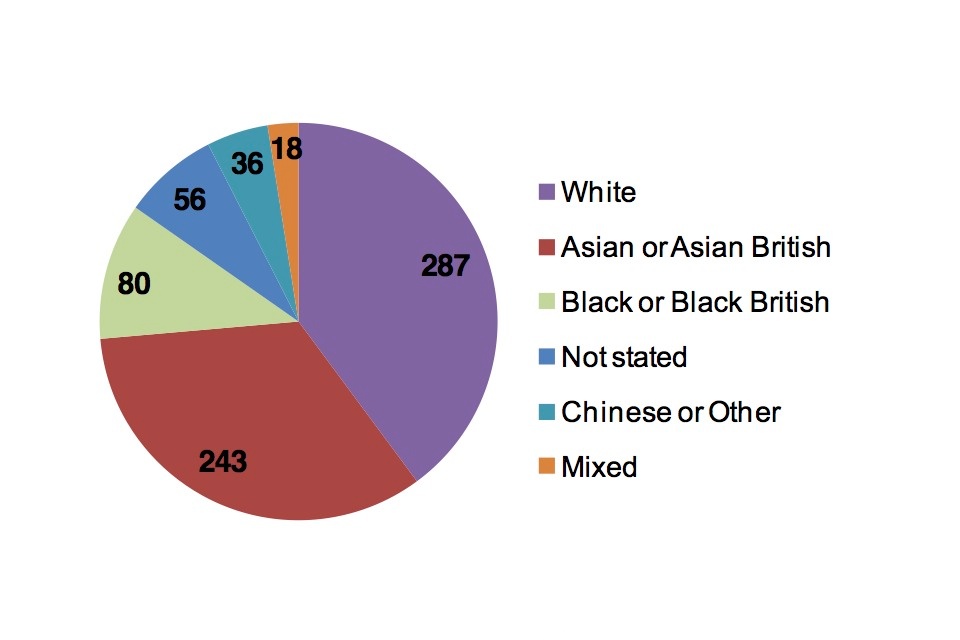Operation of police powers under the Terrorism Act 2000 and subsequent legislation, quarterly update to September 2012 (Great Britain)
Updated 8 April 2013
1. Summary
This release brings together statistical material relating to the Terrorism Act 2000, including arrests and their outcomes, as well as breakdowns of stops and searches made under the powers of the Act. Data presented here were submitted to the Home Office by the Association of Chief Police Officers, Crown Prosecution Service, National Offender Management Service, Scottish Prison Service and police forces in Great Britain, and cover the period up to 30 September 2012.
Headline figures from the bulletin show that in the year ending 30 September 2012:
- There were 245 persons arrested in Great Britain for a terrorism-related offence. Of those arrested, 45 persons were charged for a terrorism-related offence.
- Of those arrested and charged for a terrorism-related offence, 18 were convicted and 25 were awaiting prosecution (as at 18 Jan 2013).
- On 30 September 2012 there were 134 persons in prison custody for terrorism-related and extremist offences in Great Britain.
- There has, as yet, been no use of new stop and search powers under section 47A of the Terrorism Act 2000 since they were formally brought into use on 18 March 2011.
- The Metropolitan Police Service conducted 720 stops and searches under section 43 of the Terrorism Act 2000 in the year ending 30 September 2012, a fall of 41 per cent on the 1,211 in the previous year.
Information about each briefing is available in the User Guide. The guide contains further information about the Terrorism Act 2000, explains categories and terminology used in the release and gives information about the data providers.
1.1 Future changes
The following changes are planned for the future, subject to data quality and available resources:
- In order to make published figures as accessible as possible to a wide range of users, it is planned to publish tables in Open Document Spreadsheet (ODS) format rather than Microsoft Excel for future releases of these statistics. The aim is that users with most types of spreadsheet software, including Excel and open source software, will be able to download and use the ODS format workbooks in the same way as currently or with better functionality. If you have any comments on these plans please contact us via policestats@homeoffice.gsi.gov.uk.
2. Arrests and outcomes
2.1 Introduction
Statistics are presented here on the number of persons arrested by police in Great Britain, where there is suspicion of involvement with terrorism (subsequently referred to as arrests for terrorism- related offences). Outcomes of these arrests are also included up to the stage of prosecution, release, or other outcome. The information presented in this briefing is provided by the ACPO Counter Terrorism Co-ordination Centre (ACTCC), based on the latest position with each case as at the date of data provision (18 January 2013) and covers the period up to 30 September 2012.
2.2 Arrests
The relatively small numbers of terrorism arrests each year mean that proportionally large fluctuations in arrests can result from specific incidents or particular police operations.
In the year ending 30 September 2012, 245 persons were arrested for terrorism-related offences compared with 153 in the previous 12 months, an increase of 60 per cent. A total of 2,291 persons have been arrested for terrorism-related offences since 11 September 2001, an annual average of 208 persons per year.
The proportion of arrests for terrorism-related offences made under section 41 (s41) of the Terrorism Act (TACT) has fallen in recent years, from a peak of 96 per cent in 2005/06. Most recently, the proportion of terrorism-related arrests made under S41 TACT fell from 46 per cent in the year ending 30 September 2011 to 21 per cent in the year ending 30 September 2012. The proportion of terrorism-related arrests made under s41 TACT since 11 September 2001 is 71 per cent.
Persons arrested for terrorism-related offences by type of arrest and quarter

Source: Home Office, Arrests and outcomes data table A.01 (MS Excel Spreadsheet, 87.5KB)
2.3 Pre-charge detention under section 41 of the Terrorism Act 2000
When there is suspicion of involvement with terrorism-related activity, the police have the option of arresting a person under s41 of TACT, which allows detention for up to 14 days (as opposed to the maximum four days allowed under PACE).
The maximum detention period allowed under s41 of TACT has varied in recent years; further information can be found in the User Guide.
Of the 51 persons arrested under s41 of TACT in the year ending 30 September 2012, 47 (92%) were held in pre-charge detention for seven days or less.
2.4 Charges and charging rates
Of the 245 persons arrested in the year ending 30 September 2012, 94 (38%) were charged, a slightly smaller proportion than the 63 out of 153 (41%) in the previous 12 months. The charging rate in the year ending 30 September 2012 was slightly higher than the rate since 11 September 2001, which was 834 persons charged out of 2,291 arrested (36%).
Of the 94 persons charged in the year ending 30 September 2012, 45 (48%) were charged for terrorism-related offences, the remaining 49 persons (52%) were charged for non terrorism- related offences. The proportion of charges that were terrorism-related in the year ending 30 September 2012 was lower than the previous year (67%). The proportion since 11 September 2001 was 61 per cent.
Number of charges resulting from terrorism-related arrests, by quarter

Source: Home Office, Arrests and outcomes data table A.02 (MS Excel Spreadsheet, 87.5KB)
2.5 Other outcomes of arrests
Of the 245 persons arrested in the year ending 30 September 2012, 101 (41%) were released without charge with 50 (20%) dealt with by alternative action. For the 153 persons arrested in the previous year the numbers and proportions were: 82 (54%) released without charge and eight (5%) dealt with by alternative action.
Outcomes for persons arrested for terrorism-related offences between 11 September 2001 and 30 September 2012

Source: Home Office, Arrests and outcomes data table A.03 (MS Excel Spreadsheet, 87.5KB)
2.6 Court outcomes
Due to the complex nature of terrorism investigations, a trial may take place some time after an arrest or charge takes place. As a result, a high proportion of charges made in the year ending 30 September 2012 remain outstanding (56%) at the time of data provision for this release, and data presented in this briefing relating to the year ending 30 September 2012 should be interpreted with caution.
Of the 19 persons whose trials were completed in the year ending 30 September 2012, 18 were convicted and one found not guilty. The proportion of persons found guilty in the year ending 30 September 2012 is likely to change when court proceedings are concluded for all persons arrested and charged during the year (25 persons awaiting trial as at 18 Jan 2013).
The previous year provides a better indicator of recent conviction rates as a higher proportion of cases have been concluded. In the year ending 30 September 2011, 28 out of 32 persons were found guilty of an offence, with eight persons awaiting trial (as at 18 Jan 2013).
Since 11 September 2001, of the 512 persons charged for terrorism-related offences (shown in the chart above), 312 (61%) have been convicted.
2.7 Data tables
Data on persons arrested for terrorism-related offences, and the resulting charges and other outcomes, can be found at Arrests and outcomes data tables (MS Excel Spreadsheet, 87.5KB).
2.8 Data quality and interpreting the figures
In line with the normal procedures for criminal justice statistics, and in order to present an accurate count of the number of persons arrested and charged, data in this chapter have been presented on a principal offence basis. This means that, when a person is arrested or charged for multiple offences at the same time, the most serious offence is the one counted in these data. If a person arrested or charged is subsequently arrested on another occasion for a different offence, the additional arrest will also be counted in the data.
Due to the complex nature of terrorism investigations, a trial may take place several years after an arrest or charge takes place. Trials completed in 2012 can relate to arrests made in 2011 or earlier. Since the approach used in this briefing is based on time of arrest and the approach in the court proceedings briefing is based on time of trial outcome, data drawn from both may not be directly comparable.
The data presented are based on the position as at 18 January 2013, when case information was provided to the Home Office by ACTCC. As cases progress over time, outcomes can change and therefore figures for quarters previously published may be updated in this release.
For the second time in this quarterly series, final outcomes of charges made after examinations under Schedule 7 of TACT (shown in Table A.05) are included in Table A.07. As a result, data on the total number of convictions in this release are not directly comparable with convictions figures presented in editions published prior to December 2012. Further information on the change can be found in the User Guide.
3. Court proceedings
3.1 Introduction
This briefing shows data on the number of defendants tried by the Crown Prosecution Service Counter Terrorism Division (CPS CTD). Data shown here are based on final trial outcomes for each defendant (i.e. when all proceedings in each case are concluded), and are presented on the principal (most serious) offence basis. Trials which are partially completed are not included in this briefing until all proceedings are complete. This chapter includes all final trial outcomes reached between 1 July 2010 and 30 September 2012.
3.2 Key facts
Court proceedings for 29 defendants dealt with by CPS CTD were concluded in the year ending 30 September 2012, with 24 defendants convicted. Trials for 13 persons were concluded in the previous year, 7 of which resulted in conviction.
All but one of the 24 defendants convicted in the year ending 30 September 2012 received custodial sentences.
22 of the 24 defendants convicted in the year ending 30 September 2012 had pleaded guilty, compared with 2 of the 7 persons in the previous 12 months.
3.3 Data tables
Data on court proceedings dealt with by CPS CTD can be found at Court proceedings data tables (MS Excel Spreadsheet, 31KB).
3.4 Data quality and interpreting the figures
In line with the normal procedures for criminal justice statistics, and in order to present an accurate count of the number of persons dealt with by CPS CTD, data in this chapter have been presented on a principal offence basis. This means that, when a person is proceeded against for multiple offences at the same time, the most serious offence is the one counted in these data. If a person is subsequently proceeded against on another occasion for a different offence, the additional case will also be included in the dataset.
Due to the complex nature of terrorism investigations, trials may take place several years after an arrest or charge takes place. Trials completed in 2012 can relate to arrests made in 2011 or earlier. Since the approach used in the arrests and outcomes briefing is based on time of arrest and the approach in this briefing is based on time of trial outcome, data drawn from both may not be directly comparable.
4. Terrorist and extremist prisoners
4.1 Introduction
Data presented in this briefing are provided by the National Offenders Management Service and Scottish Prison Service, and show the number of persons in who were in prison custody for terrorism-related offences and the number of domestic extremist prisoners in Great Britain at the end of each quarter from 30 September 2010 to 30 September 2012. This briefing also includes data on prisoners released between 1 July 2010 and 30 September 2012.
4.2 Key facts
There were 107 persons in prison for terrorism-related offences on 30 September 2012. Additionally, there were 26 prisoners in custody who were classified as domestic extremists/separatists and also one historic terrorist prisoner (convicted prior to current terrorism legislation which came into force in 2001).
In the year ending 30 September 2012, 33 prisoners being held for terrorism or domestic extremism-related offences were discharged from prison.
4.3 Data tables
Data on persons in prison custody can be found at terrorist and extremist prisoners data tables.Terrorist and extremist prisoners data (MS Excel Spreadsheet, 28.5KB)
4.4 Data quality and interpreting the figures
Data on terrorist and extremist prisoners presented here include persons held on remand as well as those held after conviction and/or sentencing.
These data also include prisoners for historic terrorism cases originating from before 11 September 2001, who are not included in the arrests and outcomes briefing.
5. Stops and searches
5.1 Introduction
This briefing presents data on the number of uses of certain stop and search procedures available to police under the Terrorism Act 2000 (TACT).
Section 47A (s47A) of TACT allows the police to stop and search persons in order to prevent acts of terrorism, without reasonable suspicion of their involvement in terrorism. Searches under this power may only be authorised in a specific area for a defined period where the police reasonably suspect an act of terrorism will take place.
Also available to the police are powers of stop and search under s43 of TACT, where an officer does not need an authorisation as under 47A, but instead should have reasonable suspicion that the person is involved in terrorism-related activity. Data on searches under these powers presented in this briefing cover the Metropolitan Police Service area only.
Information on the legislative background to these powers can be found in the User Guide.
5.2 Stops and searches under section 43 of the Terrorism Act 2000
A total of 720 persons were stopped and searched under s43 by the Metropolitan Police Service in the year ending 30 September 2012, down from 1,211 in the previous 12 months, a fall of 41 per cent.
Of the 720 searches made in the year ending 30 September 2012, 34 (5%) resulted in arrest.
Stops and searches of persons by the Metropolitan Police Service under s43 of the Terrorism Act 2000, and resultant arrests

5.3 Section 43 searches by self-defined ethnicity
Of the 720 persons searched under s43 of TACT in the year ending 30 September 2012, the highest proportion defined themselves as White (40%), followed by Asian or Asian British (34%), Black or Black British (11%), Chinese and ‘Other’ (5%) and finally Mixed (3%). Eight per cent did not state their ethnicity in the year ending 30 September 2012.
The proportion of persons searched under s43 of TACT who defined themselves as White was four percentage points higher than the previous year. The proportion who defined themselves as Black also increased (by two percentage points) in the year ending 30 September 2012. The proportion who self-defined as Asian remained the same across the two years.
Number of section 43 searches conducted by the Metropolitan Police Service in the year ending 30 September 2012, by self-defined ethnicity

Source: Home Office, Stops and searches data table SS.03 (MS Excel Spreadsheet, 39.5KB)
5.4 Data tables
Data on stops and searches can be found at Stops and searches data tables.
